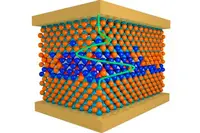 According to scientists from the University of Lancaster and spin out company Quantum Base, current authentication solutions, such as anti-counterfeit tags or password-protection, base their security on replication difficulty, or secrecy, which can be broken or forged. Looking to solve this problem, the team is using nanomaterials to create an unbreakable ID.
According to scientists from the University of Lancaster and spin out company Quantum Base, current authentication solutions, such as anti-counterfeit tags or password-protection, base their security on replication difficulty, or secrecy, which can be broken or forged. Looking to solve this problem, the team is using nanomaterials to create an unbreakable ID.
The approach – called Q-ID – is said to derive its security from the unique arrangement of atoms created during epitaxy, the process used to create semiconductors and semiconducting diodes.
Q-ID embeds a resonant tunnelling diode into a device. This comprises a layer of indium gallium arsenide sandwiched between two layers of aluminium arsenide. When a voltage sweep is performed, a spectrum – or fingerprint – is produced that is unique to that device.
Dr Robert Young, research fellow and lecturer at the University of Lancaster, said: “If you want to keep your smartphone secure, you can either use a long password or a fingerprint. The fingerprint is easier to use and more complex than a password.
“Simulating Q-ID ‘fingerprints’ requires vast computing power and is not achievable in a reasonable timescale, even with a quantum computer. When coupled with the fact that the underlying structure is unknown, unless dismantled atom-by-atom, this makes simulation extremely difficult.”
It is claimed the Q-ID approach can be integrated into existing chip manufacturing processes, enabling products to be tracked throughout the supply chain.
Dr Young said: “One could imagine our devices being used in industries with high counterfeiting rates to identify a range of products, from spare parts for electronic goods, such as iPhone batteries, to verifying the ingredients of individual pills in pharmaceuticals. With this technology, the parts can be verified as genuine so consumers don’t get fooled into buying fake goods that can be defective or even dangerous. The possibilities are endless.”
Lancaster and Quantum Base are talking to manufacturers in aerospace, consumer electrical, automotive and pharmaceuticals about integrating the device into their production processes.
Pic: When a voltage sweep is performed through this layer of indium gallium arsenide sandwiched between two layers of aluminium arsenide, a spectrum – or fingerprint – is produced that is unique to that device
Author
Tom Austin-Morgan
Source: www.newelectronics.co.uk

